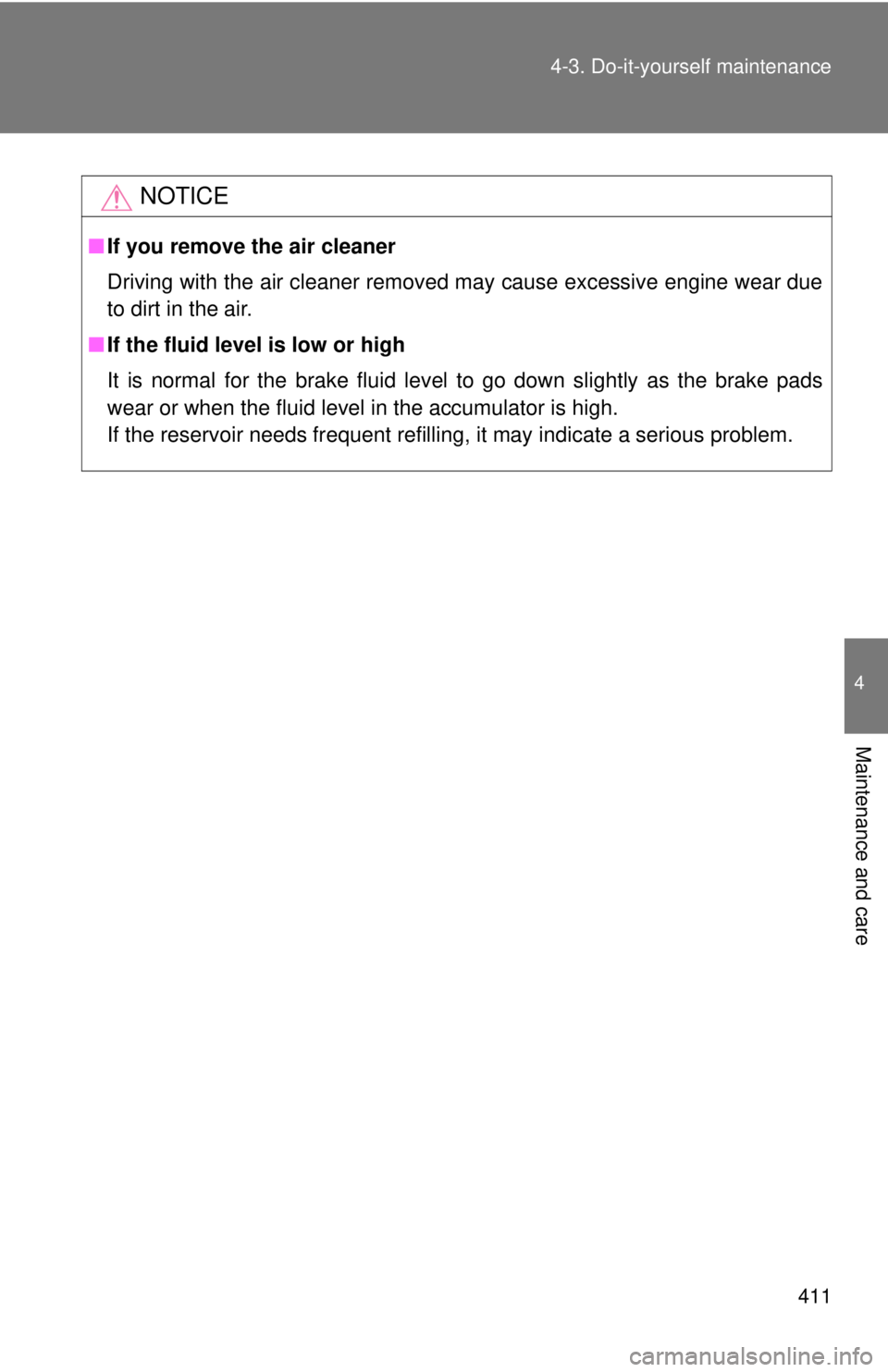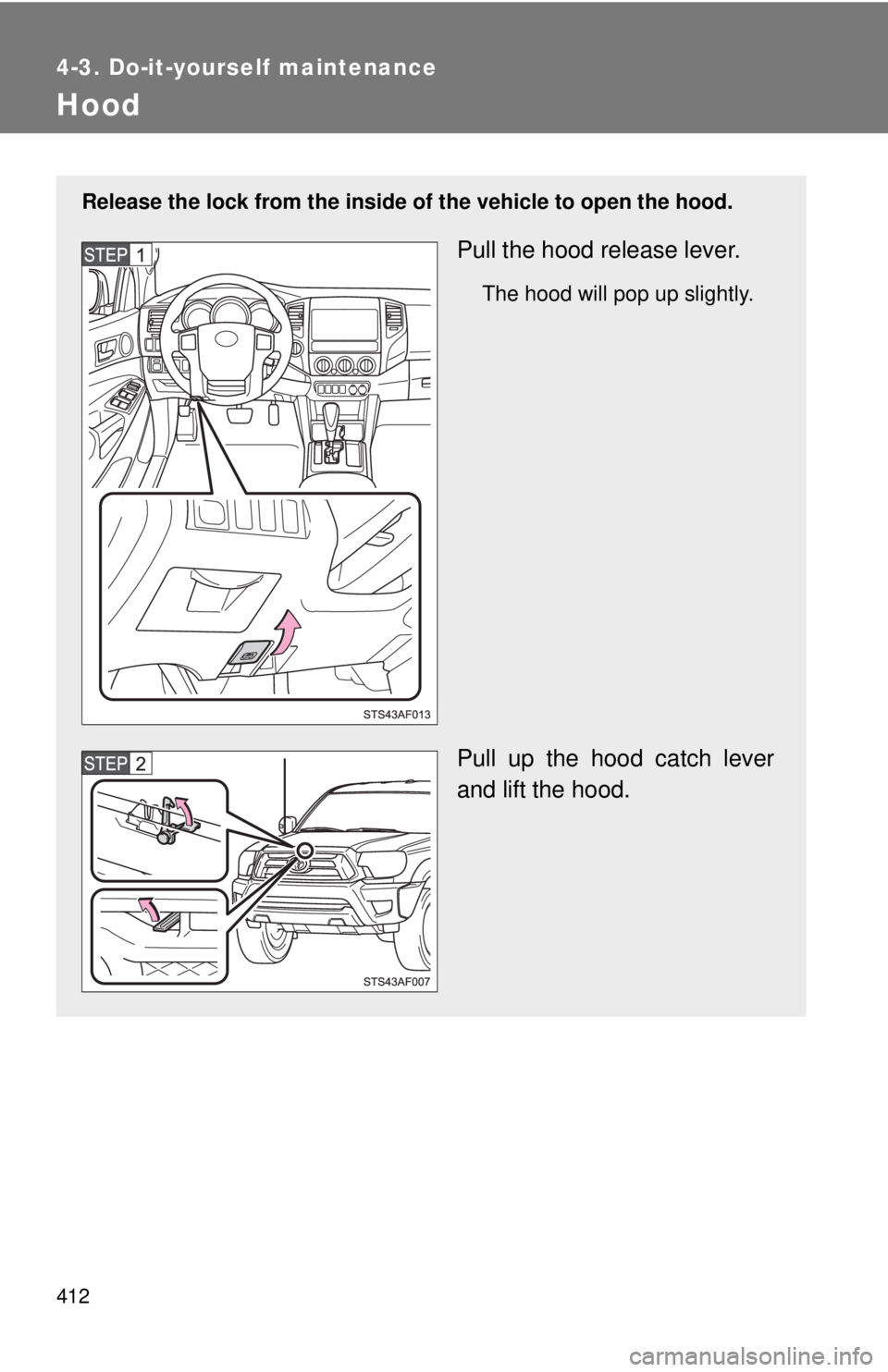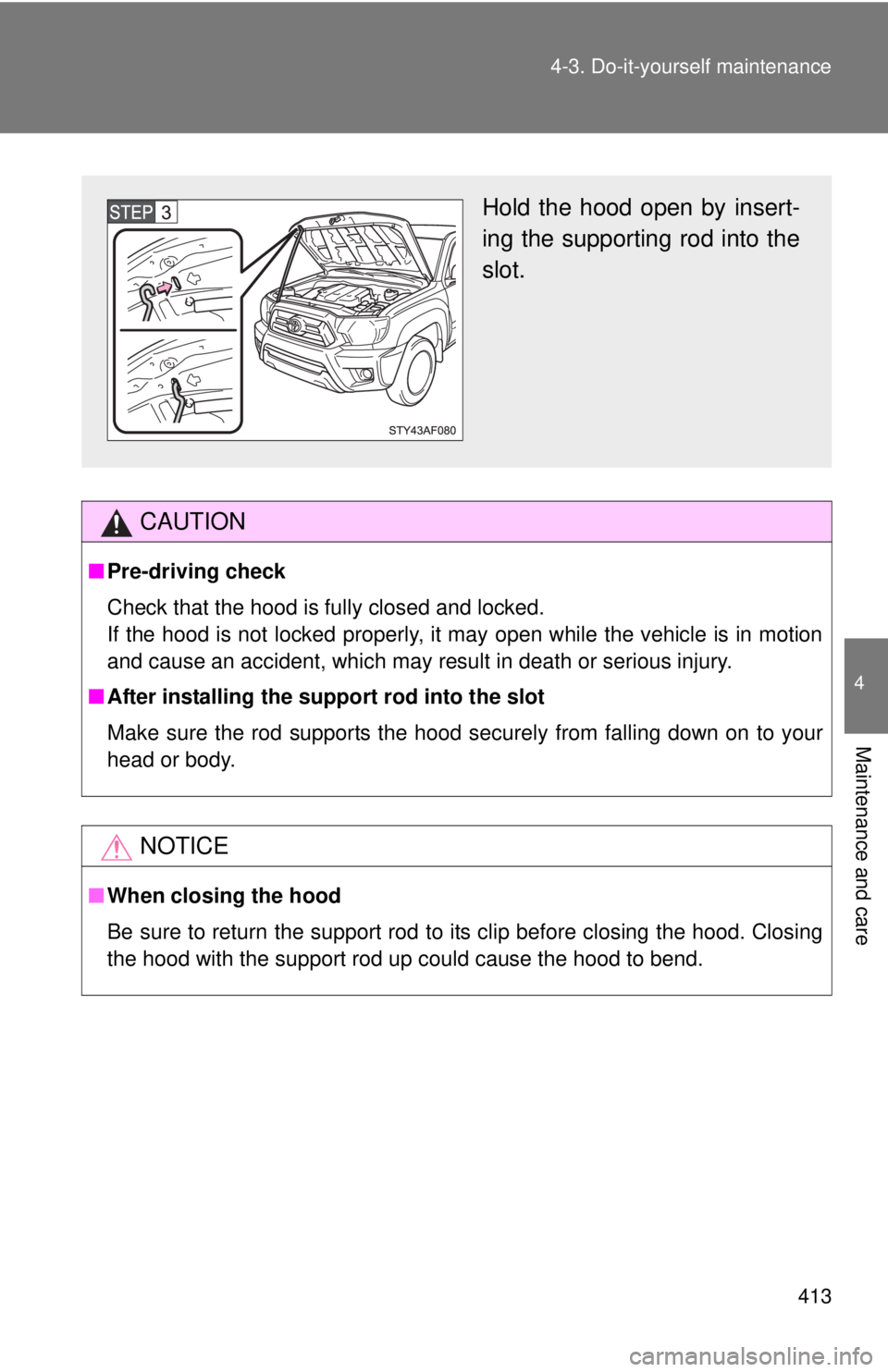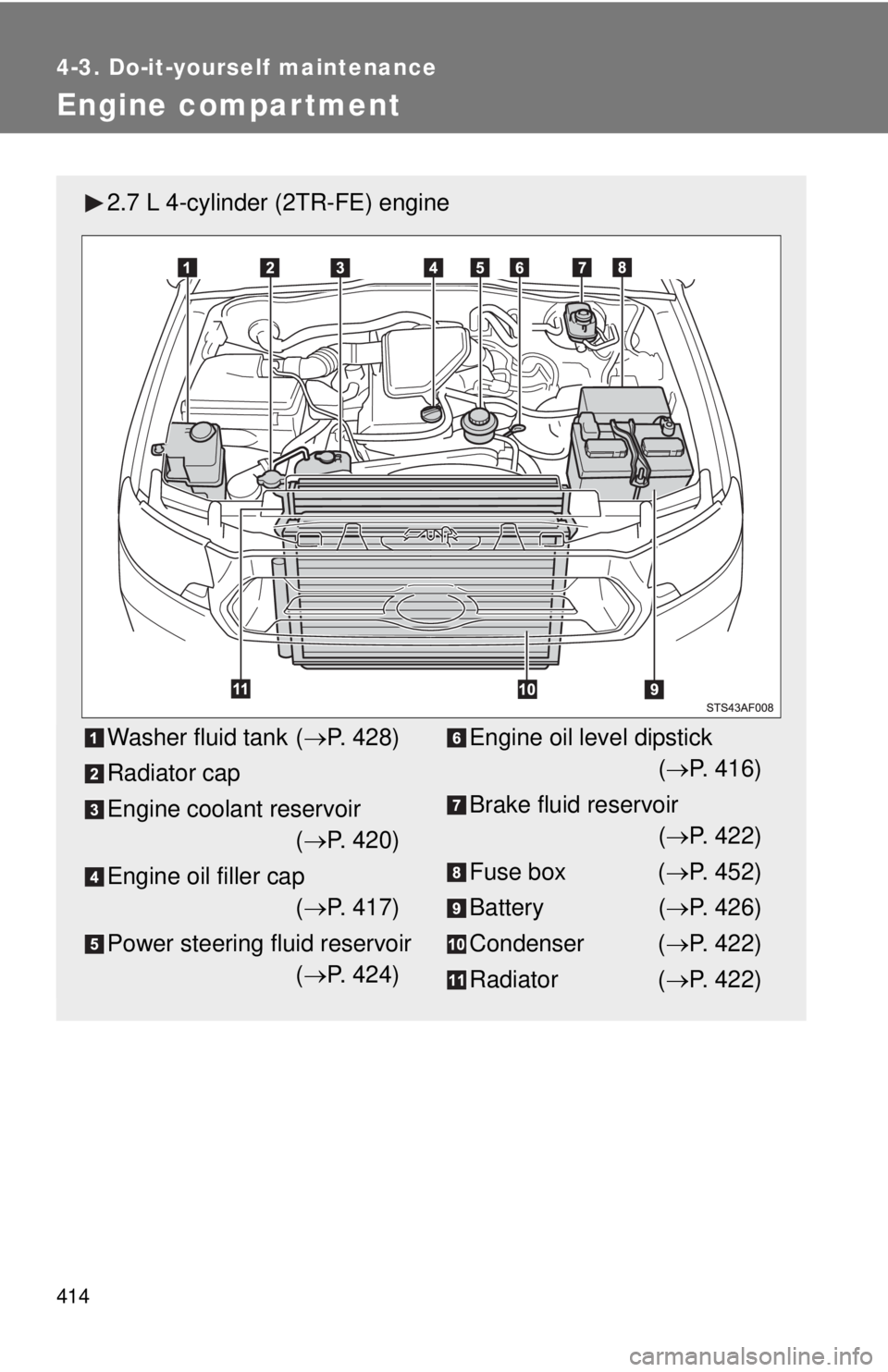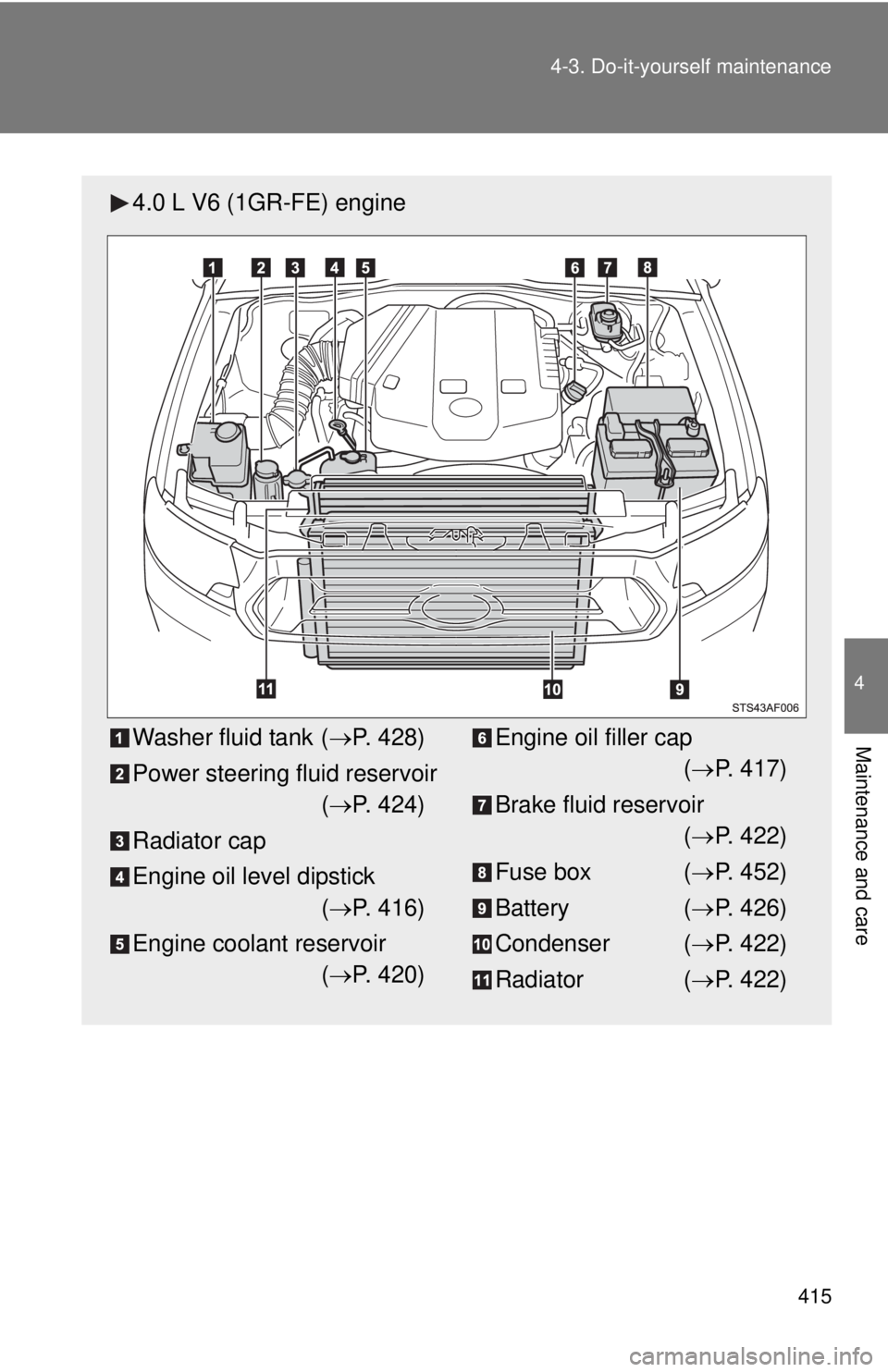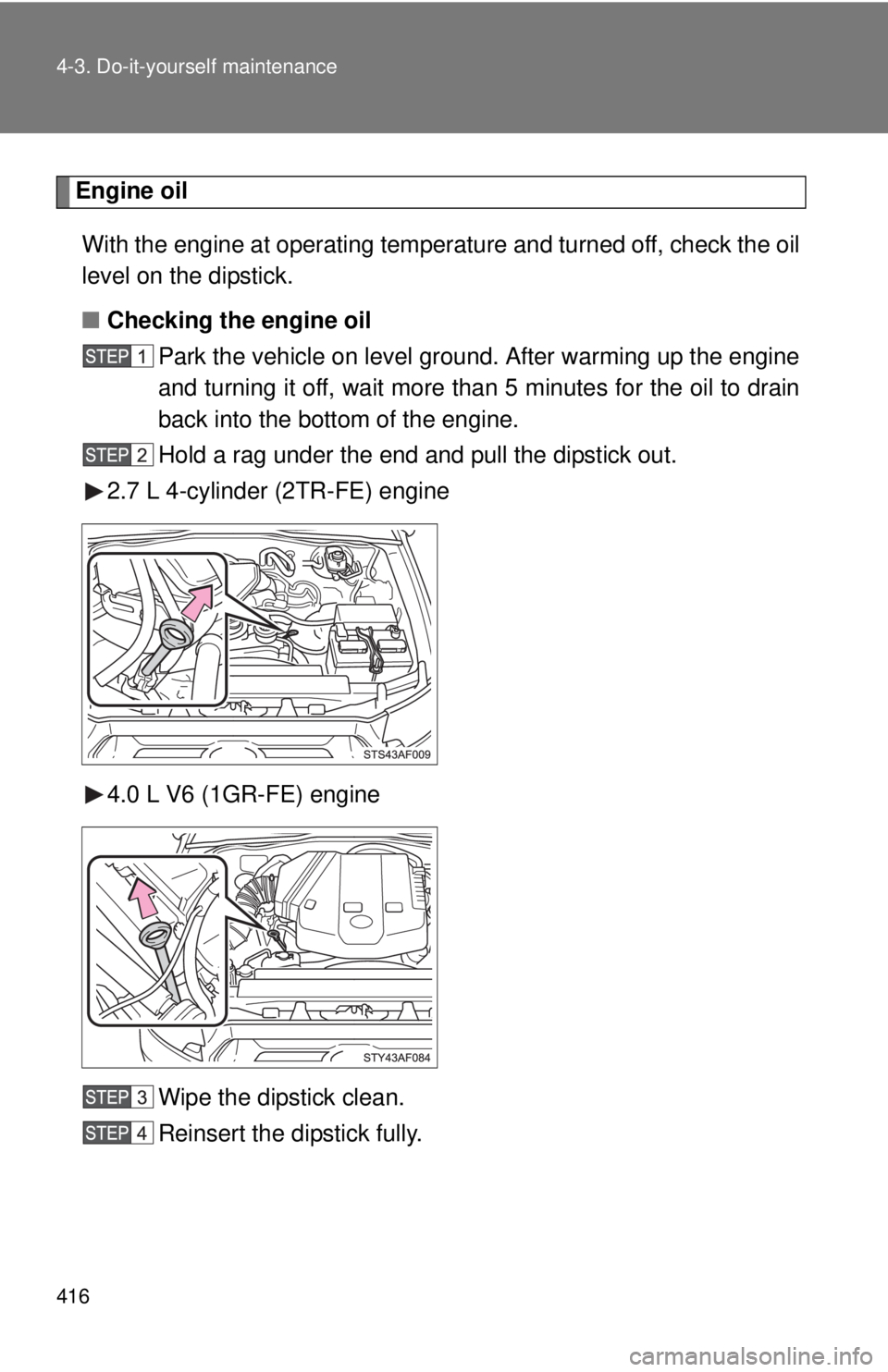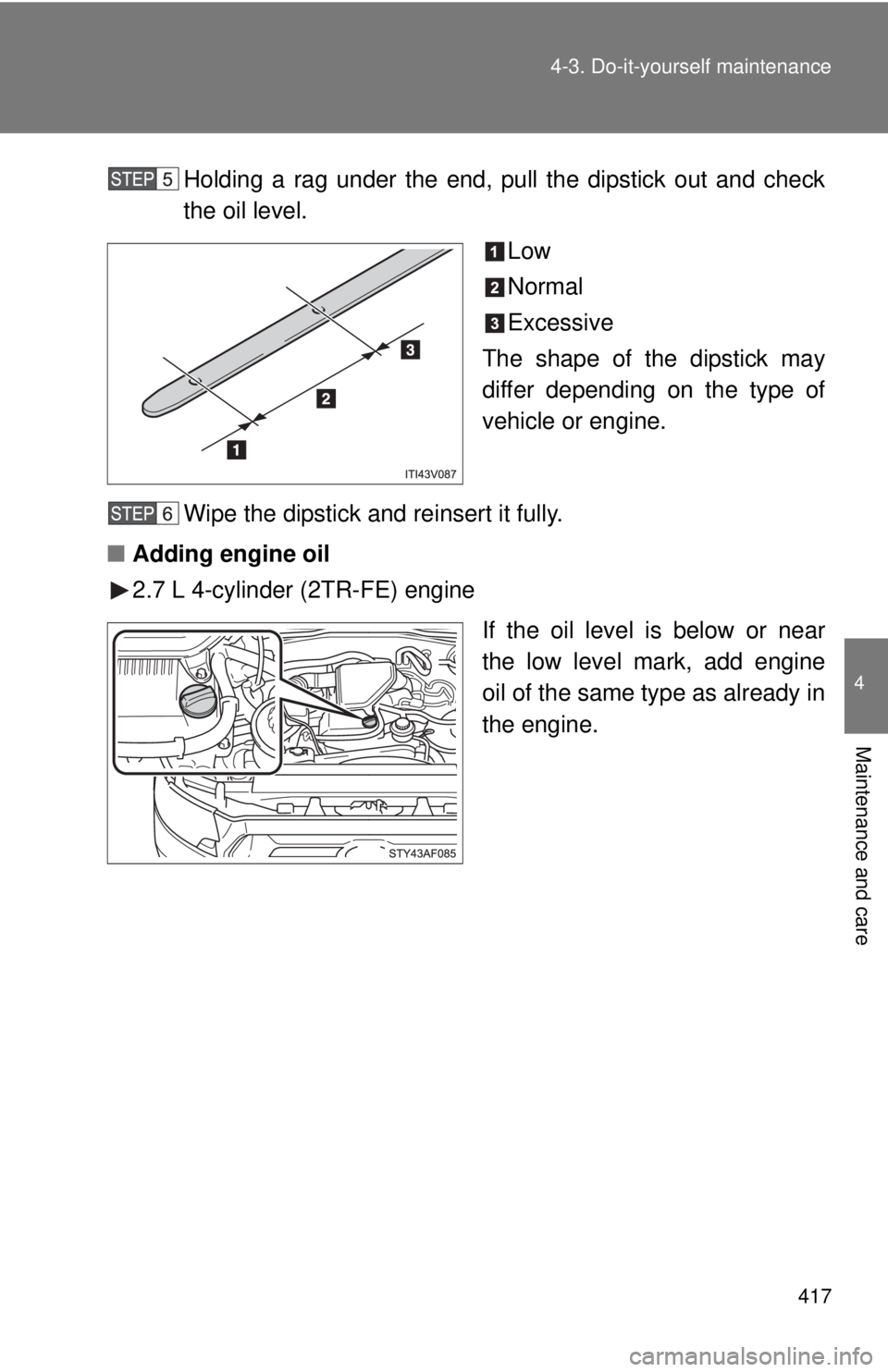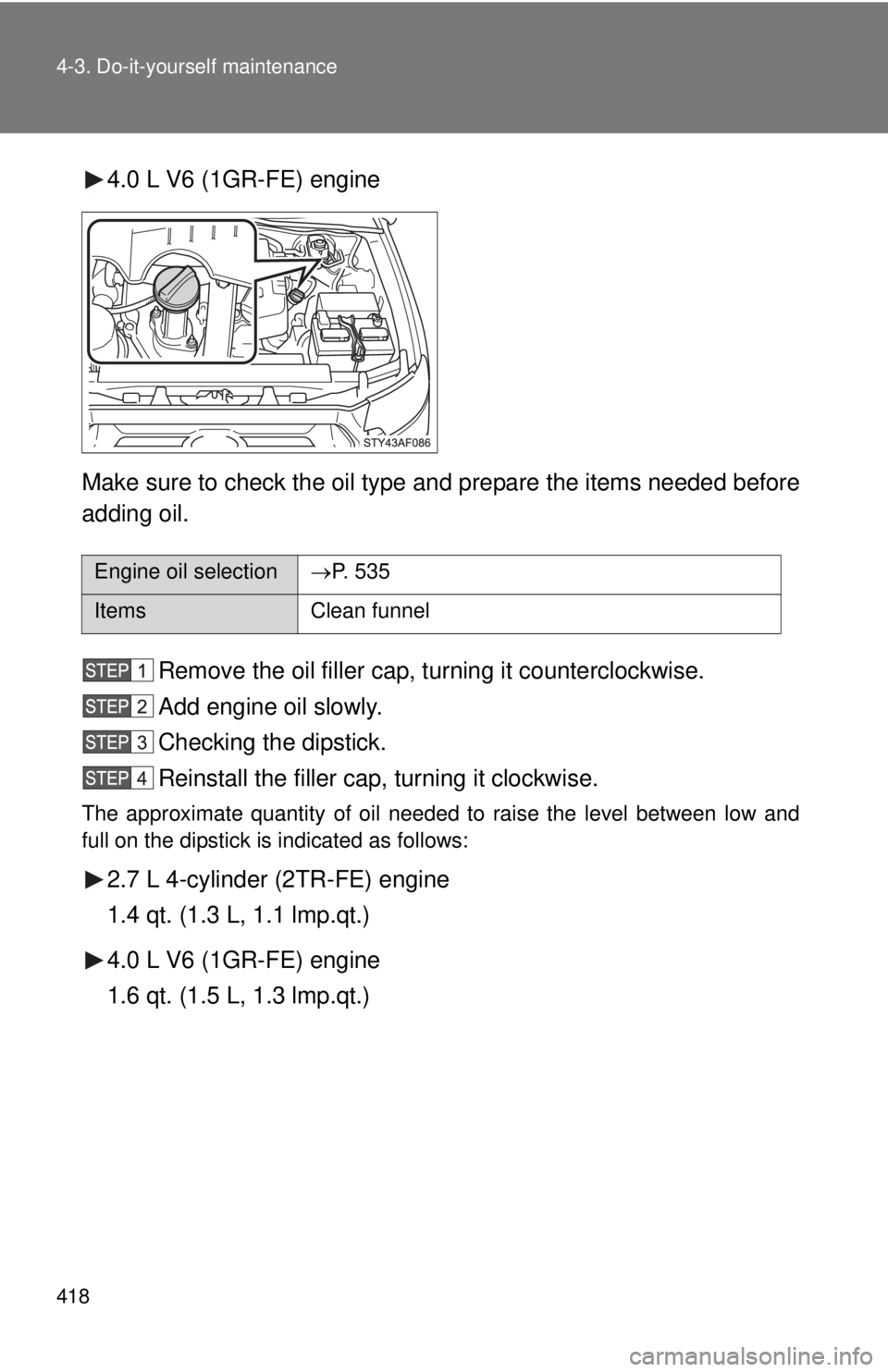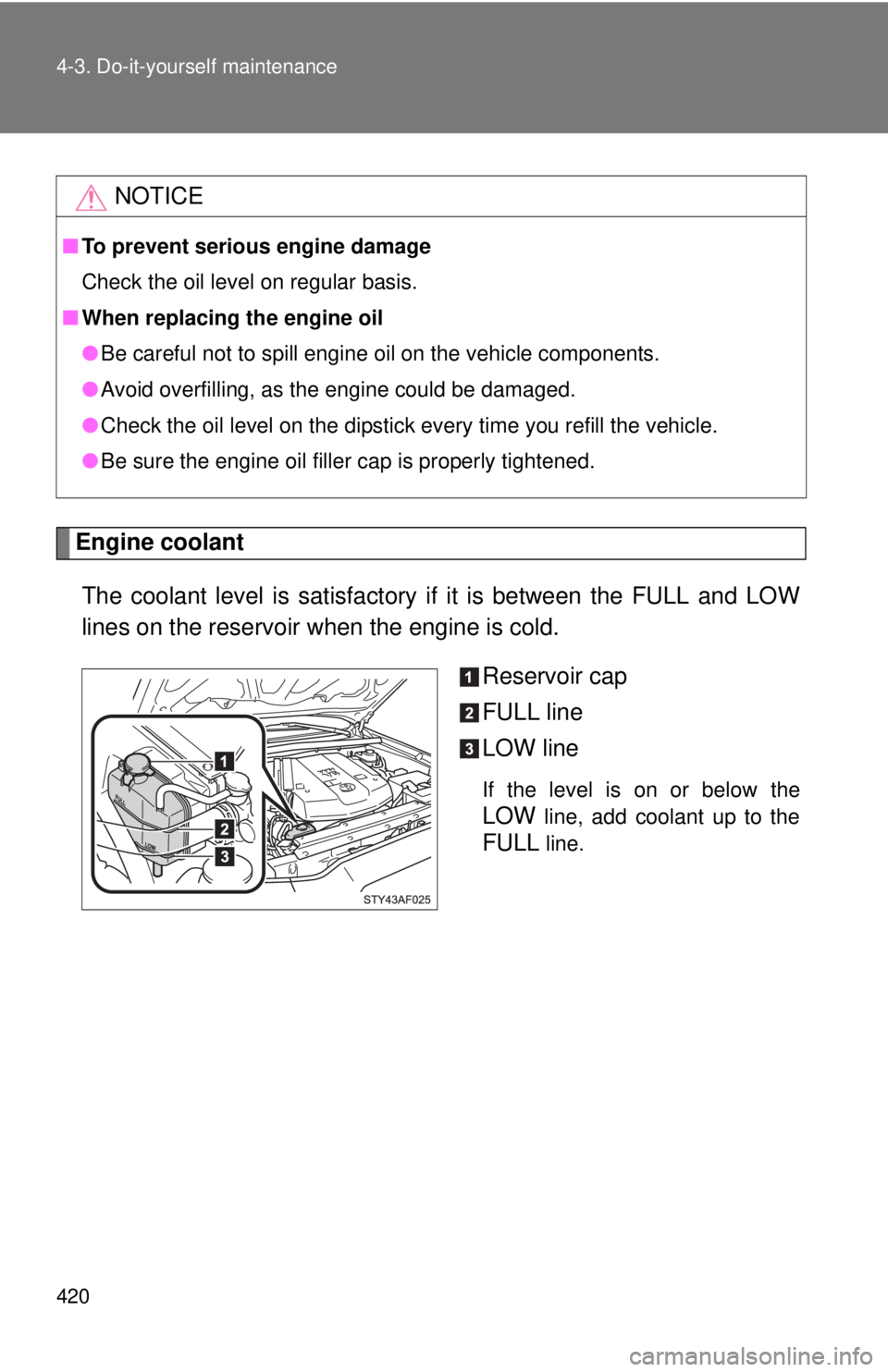TOYOTA TACOMA 2014 Owners Manual (in English)
TACOMA 2014
TOYOTA
TOYOTA
https://www.carmanualsonline.info/img/14/42977/w960_42977-0.png
TOYOTA TACOMA 2014 Owners Manual (in English)
Trending: air suspension, service reset, oil, engine oil, wiring, torque, air filter
Page 411 of 601
411
4-3. Do-it-yourself maintenance
4
Maintenance and care
NOTICE
■
If you remove the air cleaner
Driving with the air cleaner removed may cause excessive engine wear due
to dirt in the air.
■ If the fluid level is low or high
It is normal for the brake fluid level to go down slightly as the brake pads
wear or when the fluid level in the accumulator is high.
If the reservoir needs frequent refilling, it may indicate a serious pro\
blem.
Page 412 of 601
412
4-3. Do-it-yourself maintenance
Hood
Release the lock from the inside of the vehicle to open the hood.
Pull the hood release lever.
The hood will pop up slightly.
Pull up the hood catch lever
and lift the hood.
Page 413 of 601
413
4-3. Do-it-yourself maintenance
4
Maintenance and care
CAUTION
■
Pre-driving check
Check that the hood is fully closed and locked.
If the hood is not locked properly, it may open while the vehicle is in motion
and cause an accident, which may result in death or serious injury.
■ After installing the support rod into the slot
Make sure the rod supports the hood securely from falling down on to your
head or body.
NOTICE
■When closing the hood
Be sure to return the support rod to its clip before closing the hood. Closing
the hood with the support rod up could cause the hood to bend.
Hold the hood open by insert-
ing the supporting rod into the
slot.
Page 414 of 601
414
4-3. Do-it-yourself maintenance
Engine compar tment
2.7 L 4-cylinder (2TR-FE) engine
Washer fluid tank (P. 428)
Radiator cap
Engine coolant reservoir ( P. 420)
Engine oil filler cap ( P. 417)
Power steering fluid reservoir ( P. 424)Engine oil level dipstick
( P. 416)
Brake fluid reservoir ( P. 422)
Fuse box ( P. 452)
Battery ( P. 426)
Condenser ( P. 422)
Radiator ( P. 422)
Page 415 of 601
415
4-3. Do-it-yourself maintenance
4
Maintenance and care
4.0 L V6 (1GR-FE) engine
Washer fluid tank (
P. 428)
Power steering fluid reservoir ( P. 424)
Radiator cap
Engine oil level dipstick ( P. 416)
Engine coolant reservoir ( P. 420)Engine oil filler cap
( P. 417)
Brake fluid reservoir ( P. 422)
Fuse box ( P. 452)
Battery ( P. 426)
Condenser ( P. 422)
Radiator ( P. 422)
Page 416 of 601
416 4-3. Do-it-yourself maintenance
Engine oil
Engine oilWith the engine at operating temperature and turned off, check the oil
level on the dipstick.
■ Checking the engine oil
Park the vehicle on level ground. After warming up the engine
and turning it off, wait more than 5 minutes for the oil to drain
back into the bottom of the engine.
Hold a rag under the end and pull the dipstick out.
2.7 L 4-cylinder (2TR-FE) engine
4.0 L V6 (1GR-FE) engine
Wipe the dipstick clean.
Reinsert the dipstick fully.
Page 417 of 601
417
4-3. Do-it-yourself maintenance
4
Maintenance and care
Holding a rag under the end, pull the dipstick out and check
the oil level.
Low
Normal
Excessive
The shape of the dipstick may
differ depending on the type of
vehicle or engine.
Wipe the dipstick and reinsert it fully.
■ Adding engine oil
2.7 L 4-cylinder (2TR-FE) engine
If the oil level is below or near
the low level mark, add engine
oil of the same type as already in
the engine.
Page 418 of 601
418 4-3. Do-it-yourself maintenance
4.0 L V6 (1GR-FE) engine
Make sure to check the oil type and prepare the items needed before
adding oil. Remove the oil filler cap, turning it counterclockwise.
Add engine oil slowly.
Checking the dipstick.
Reinstall the filler cap, turning it clockwise.
The approximate quantity of oil needed to raise the level between low and
full on the dipstick is indicated as follows:
2.7 L 4-cylinder (2TR-FE) engine
1.4 qt. (1.3 L, 1.1 lmp.qt.)
4.0 L V6 (1GR-FE) engine
1.6 qt. (1.5 L, 1.3 lmp.qt.)
Engine oil selection P. 535
ItemsClean funnel
Page 419 of 601
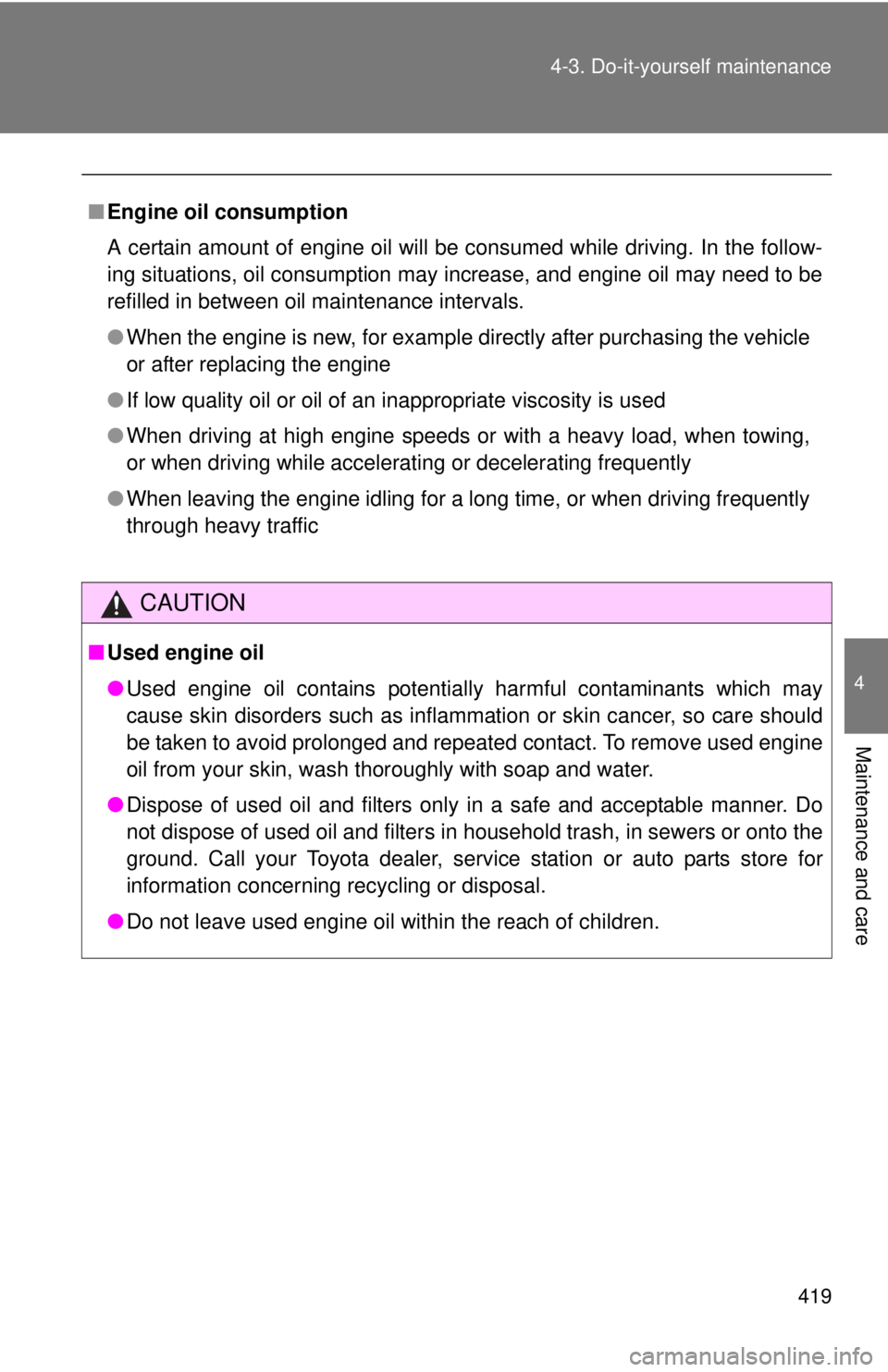
419
4-3. Do-it-yourself maintenance
4
Maintenance and care
■
Engine oil consumption
A certain amount of engine oil will be consumed while driving. In the follow-
ing situations, oil consumption may increase, and engine oil may need to be
refilled in between oil maintenance intervals.
●When the engine is new, for example directly after purchasing the vehicle
or after replacing the engine
● If low quality oil or oil of an inappropriate viscosity is used
● When driving at high engine speeds or with a heavy load, when towing,
or when driving while accelerating or decelerating frequently
● When leaving the engine idling for a long time, or when driving frequently
through heavy traffic
CAUTION
■Used engine oil
●Used engine oil contains potentially harmful contaminants which may
cause skin disorders such as inflammation or skin cancer, so care should
be taken to avoid prolonged and repeated contact. To remove used engine
oil from your skin, wash thoroughly with soap and water.
● Dispose of used oil and filters only in a safe and acceptable manner. Do
not dispose of used oil and filters in household trash, in sewers or onto the
ground. Call your Toyota dealer, service station or auto parts store for
information concerning recycling or disposal.
● Do not leave used engine oil within the reach of children.
Page 420 of 601
420 4-3. Do-it-yourself maintenance
Engine coolantThe coolant level is satisfactory if it is between the FULL and LOW
lines on the reservoir when the engine is cold. Reservoir cap
FULL line
LOW line
If the level is on or below the
LOW line, add coolant up to the
FULL line.
NOTICE
■To prevent serious engine damage
Check the oil level on regular basis.
■ When replacing the engine oil
●Be careful not to spill engine oil on the vehicle components.
● Avoid overfilling, as the engine could be damaged.
● Check the oil level on the dipstick every time you refill the vehicle.
● Be sure the engine oil filler cap is properly tightened.
Trending: fuel cap, ESP, height, emergency towing, maintenance schedule, oil reset, USB
